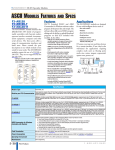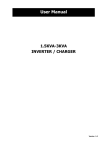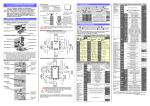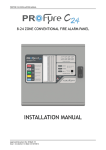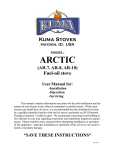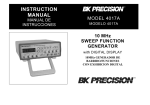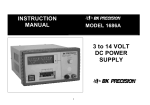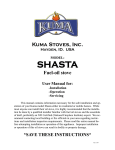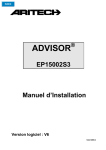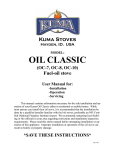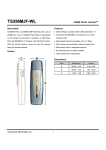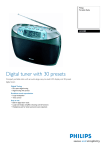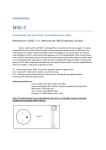Download 307A Manual(1832 IN)
Transcript
Instruction Manual Model 307A Analog Insulation & Continuity Meter Index Safety Precautions........................................ Safety Notes................................................. Features ...................................................... Connections ................................................ Specifications ...... ....................................... Why Test is necessary ................................. Instrument Layout ........................................ Lid Instruction Label .................................... Preparation for Measurement ..................... Functions .............................. ...................... Battery & Fuse Replacement ....................... Calibration & Servicing ................................. Cleaning & Storage....................................... Limited One-year Warranty........................... Service Information....................................... Page 1 2 2-3 3 4 5 6 7 8 8-14 15 16 16 17 18 YOUR COMMENTS ARE IMPORTANT TO US We have become a market leader in test and measurement in recent years, due to the company's ability to design and bring to the market innovative instruments and devices which offer real customer benefits. The cornerstone of this ability is the company's focus on customer requirements and the emphasis placed on end-user satisfaction. We appreciate customer information and requirement to improve or design new products. 1. 1.1 1.2 1.3 1.4 1.5 1.6 1.7 1.8 Safety Precautions Electricity can cause severe injuries even with low voltages or currents. Therefore it is extremely important that you read the following information before using your Analog Insulation Tester. This Instrument must only be used and operated by a competent trained person and in strict accordance with the instructions. We will not accept liability for any damage or injury caused by misuse or non compliance with instructions and safety procedures. This Instrument must not be used on live circuits. Ensure all circuits are de-energised before testing. See paragraph 1.8 for details of built-in warning features should your Analog Insulation tester be connected to a live system. Never open Your Analog Insulation Tester except for battery replacement. (See Battery replacement section). Always inspect you Analog Insulation tester and test leads before use for any sign of abnormality or damage. If any abnormal conditions exist (broken test leads, cracked case, display faulty etc...) do not attempt to take any measurement or use the tester. Return your Analog Insulation tester to your nearest Distributor for Service. Never replace the protective fuse with any other than the specified or approved equivalent. Your Analog Insulation tester has been designed with your safety in mind. However, no design can completely protect against incorrect use. Electrical circuits can be dangerous and/or lethal when a lack of caution or poor safety practice is used. Use caution in the presence of voltage above 24V as these pose a shock hazard. Pay attention to cautions and warnings which will inform you of potentially dangerous procedures. Your Analog Insulation Tester has a live circuit warning bleeper. If it is connected to an AC live circuit, a beep of twice the frequency of the voltage present will be heard. DO NOT proceed to test and immediately disconnect the instrument from the circuit. In addition, the warning light will lit if the voltage is above 100Vdc or 70Vac. When AC voltage is present, before testing, it's value is displayed on the AC scale. -1- 2. Safety Notes Rated environmental conditions (1). Indoor use. (2). Installation Category . (3). Pollution Degree 2. (4). Altitude up to 2000M Meter is protected throughout by double insulation or reinforced insulation. Warning ! Risk of electric shock. Caution ! Refer to this manual before using the meter. 3. Features Ÿ High Quality Taut Band movement. Ÿ Three Insulation test voltages Ÿ Ÿ Ÿ Ÿ Ÿ Ÿ Ÿ Ÿ Ÿ Ÿ 1- 250Vdc -100MW 2- 500Vdc -200MW 3- 1000Vdc -400MW Two Continuity Test on Low Ohms 500W & 3W Designed to meet IEC 1010-1 safety standard.. Small and Lightweight, all in one case (do not need bag). AC voltmeter with linear scale up to 600Vac. 200mA continuity short circuit current. 1mA test current on Insulation Test at nominal voltage. Automatic discharge of capacitance and inductive circuit with charge stored in the circuit under test. Live Warning and display of external voltage presence. Fuse, Air Gap, Crowbar and Overload Protected. On line battery monitoring shows if battery is ok.. -2- Ÿ Auto null of the test leads on continuity tests. Ÿ Very Low Battery Consumption. Ÿ On-Load battery check (+/-205mA load for worst case) operates on 8 dry batteries (AA, R6P type..) Ÿ Mirror scale. Ÿ Push and Turn locking switch for long and hand free testing. Ÿ Designed to meet international standards. Ÿ Supplied with High Quality test leads. 4. Connections ! LINE CAT. III MAX 600V -3- EARTH 5. Specifications INSULATION Test Voltage 250Vdc 500Vdc 1000Vdc +10%-0% +10%-0% +10%-0% Mirror scale 100MW 200MW 400MW Mid Scale 1MW 2MW 4MW Scale Multiplier x1/2 x1 x2 Accuracy ±3% Output Short-Circuit Current 1.3mA Regulated Output Voltage (up to 1mA current) 263.5V / 525V / 1052V CONTINUITY Low W 0 - 3W 0 - 500 W Test Leads / Fuse Zero W Adjustment by knob Output Short-Circuit Current 205mA Accuracy ±1.5% of scale length AC Voltage Range Accuracy 0 - 600Vac ±3% of scale length Voltage Warning Warning Light Circuit Live lit from 90Vdc / 70Vac Buzzer Beep from 24Vac / dc Battery Check Battery Check indicate good batteries from 8Vdc to 13Vdc during a Load test of 205mA. Battery OK Battery OK Led lit from 8Vdc and is operative while testing. -4- 6. Why test is necessary ? INSULATION Every electrical apparatus and installation need to be safe for the user and for the equipment itself. Electrical conductors of electricity need to be insulated from each other, so that they do not create electrical hazard or unnecessary consumption. Badly insulated circuits can create leakage current which can be dangerous and trip your GFCI, RCCB or ELCB.. Each country regulate those levels at which the insulation is acceptable. Generally, Insulation resistance measurements are done between each conductor and the earth, and between each conductors. CONTINUITY Checking the continuity of wires, complete circuits, connections, closure of contacts, circuit breakers, fuses, bounding resistance of connections, etc... Are all very important. -5- 7. Instrument Layout 4 3 5 N-E P-E ! FOR Vac: DO NOT PRESS PRESS TO TEST INSULATION MW 1000V/400MW ! 500V/200MW 250V/100MW 3W 500W LOCK 1 Batt. Check W CONTINUITY FOR CONTINUOUS TESTING, PRESS AND TURN ALWAYS ENSURE CIRCUIT TO TEST IS FREE OF VOLTAGE BEFORE PROCEEDING WITH CONTINUITY OR INSULATION TESTING. CATIII 600V 0W ZERO OHM ADJUST INSULATION-CONTINUITY METER 1. Test Button Switch. 2. Function Selector 3. Battery OK indicator 4. Mirror Scale 5. Live Circuit Warning Light 6. Test Leads and Fuse Zeroing Knob -6- 2 6 INSTRUCTIONS ANALOG INSULATION-CONTINUITY TESTER -7- CONTINUITY TESTS - W Ranges 1. Select the desired ohm range, 3W or 500W. 2. Short the test leads, press test button and adjust the ohms zero ADJ to zero the pointer on the 0W (green scale) 3. Check the circuit is not LIVE. 4. Connect the test leads to the circuit under test. Press the test button. Read the selected range directly. GENERAL: Ÿ For AC Voltmeter, do not press test button, this is the default mode of the instrument. Ÿ AC Voltmeter can works without batteries. Ÿ Insulation or Continuity mode: for continous operation, press and turn the test button. SAFETY PRECAUTION ! Ÿ The circuit must not be LIVE, conduct initial checks first. If at any time , the "LIVE"circuit light is lit, or the warning buzzer sounds - DO NOT PROCEED, the circuit is live. Ÿ Using the instrument in Insulation Mode may leave the circuits charged up if test leads are removed too quickly. Avoid this by releasing the test button while the test leads are still connected to the circuit for a few seconds. INSULATION TESTS MW Ranges 1. Select the desired insulation test voltage range, 250V, 500V, or 1000V. 2. Connect the leads to the instrument and circuit under test. 3. Check the circuit is not LIVE. 4. Press the test button. Read the red MW scale directly for 500V, multiply by 0.5 (or divide by 2) for 250V and multiply by 2 for 1000V. WARNING: This instrument must only be used by a competent trained individual. Consult the full operating instructions. Never press the test button before connecting test leads to circuit to test. INITIAL CHECKS: 1. Switch to "Batt. Check" and depress the test button. If the pointer does not move to "BATT. GOOD", the battery needs to be replaced before proceeding. 2. Connect test leads to instrument, switch to 3W. Press and turn the test button (continuous mode), short the test leads. The pointer should swing from infinite towards zero. 8. Lid Instruction Label 9.Preparation for Measurement Before testing Always check the following. At Power "ON", check that Bat. OK led lit. And check that there is no visual damage to the Instrument or test leads. Check the test Leads continuity 1. Connect the leads to the Instrument. 2. Zero the test leads while on the 3 ohm range.. 3. This will indicate your that continuity of the test leads is ok. 4. Verify that the test leads insulation is in good condition. 10. Functions 10.1 Battery Check FOR Vac: DO NOT PRESS PRESS TO TEST ! INSULATION MW 1000V/400MW 500V/200MW 250V/100MW 3W N-E LOCK ! 500W P-E Batt. Check W CONTINUITY FOR CONTINUOUS TESTING, PRESS AND TURN Turn the function selector to Batt. Check. This function has a load which draw about 205mA when test is performed, and therefore it is doing a worst case battery test. Then, press the test button, the pointer should be in the Bat. Good area. During the test, the bat. OK Led (on line battery check) must lit if the pointer is in the bat. Good area. -8- 10.2 DC Warning The DC warning buzzer will beep continuously when DC voltage is higher than 30Vdc on the test probes and the test button is Not pressed. The neon light "circuit live" will lit when the voltage on the test probes is higher than 90Vdc and the test button is not pressed. 10.3 AC Warning The AC warning buzzer will beep continuously when AC voltage is higher than 20Vac on the test probes and the test button is Not pressed. The neon light "circuit live" will lit when the voltage on the test probes is higher than 65Vdc and the test button is not pressed. 10.4 AC Measurement The AC measurement is automatic on this instrument. as soon as AC voltage is present on the test leads, the instrument will display the AC voltage from 20 to 600Vac on the linear scale. -9- 10.5 Low ohms measurement 0 - 500W FOR Vac: DO NOT PRESS PRESS TO TEST ! INSULATION MW 1000V/400MW 500V/200MW 250V/100MW 3W N-E LOCK ! 500W P-E Batt. Check W CONTINUITY FOR CONTINUOUS TESTING, PRESS AND TURN Always check for voltage before testing and measuring on a circuit. This instrument is intended for measuring Low W and Insulation resistance on un-energized circuits only. Use the procedure explained at points 7.2, 7.3, 7.4. The first procedure to follow, is to zero the test leads and the fuse resistance. The instrument is equipped with a Zero W Knob. First, short circuit the test leads by connecting them together, then, press the test button and adjust the zero W knob until the pointer is precisely on the "0" of the 500W scale. Use the mirror scale to be precise With the pointer. Connect the test leads to the circuit 0W to be measured. ZERO OHM For short test, press button and keep ADJUST pressed. For long test or hand free Measurements, press and turn the test button. -10- 10.6 Low ohms measurement 0 - 3W FOR Vac: DO NOT PRESS PRESS TO TEST ! INSULATION MW 1000V/400MW 500V/200MW 250V/100MW 3W N-E LOCK ! FOR CONTINUOUS TESTING, PRESS AND TURN 500W P-E Batt. Check W CONTINUITY Always check for voltage before testing and measuring on a circuit. This instrument is intended for measuring Low W and Insulation resistance on un-energized circuits only. Use the procedure explained at points 7.2, 7.3, 7.4. The first procedure to follow, is to zero the test leads and the fuse resistance. The instrument is equipped with a Zero W Knob. First, short circuit the test leads by connecting them together, then, press the test button and adjust the Zero W knob until the pointer is precisely on the "0" of the 3W scale. Use the mirror scale to be precise with the pointer. Connect the test leads to the circuit 0W to be measured. ZERO OHM For short test, press button and keep ADJUST pressed. For long test or hand free Measurements, press and turn the test button. -11- 10.7 Insulation Resistance Measurement @ 250Vdc FOR Vac: DO NOT PRESS PRESS TO TEST ! INSULATION MW 1000V/400MW 500V/200MW 250V/100MW 3W N-E LOCK ! 500W P-E Batt. Check W CONTINUITY FOR CONTINUOUS TESTING, PRESS AND TURN Always check for voltage before testing and measuring on a circuit. This instrument is intended for measuring Low W and Insulation resistance on un-energized circuits only. Use the procedure explained at points 7.2, 7.3, 7.4. Check the test leads and fuse resistance byzeroing the test leads and fuse as per the 7.6 procedure. Connect the test leads to the circuit to be measured and wait for a few seconds. The instrument will automatically discharge any remaining energy which could be present on the circuit, and will check for voltage at the same time. Once you are sure that the circuit to be tested is not Energized, then press the button for a short test duration or press and turn the button for a long test. Once you end the test, allow a few seconds for the Instrument to automatically discharge the circuit. -12- 10.8 Insulation Resistance Measurement @ 500Vdc FOR Vac: DO NOT PRESS PRESS TO TEST ! INSULATION MW 1000V/400MW 500V/200MW 250V/100MW 3W N-E LOCK ! 500W P-E Batt. Check W CONTINUITY FOR CONTINUOUS TESTING, PRESS AND TURN Always check for voltage before testing and measuring on a circuit. This instrument is intended for measuring Low W and Insulation resistance on un-energized circuits only. Use the procedure explained at points 7.2, 7.3, 7.4. Check the test leads and fuse resistance byzeroing the test leads and fuse as per the 7.6 procedure. Connect the test leads to the circuit to be measured and wait for a few seconds. The instrument will automatically discharge any remaining energy which could be present on the circuit, and will check for voltage at the same time. Once you are sure that the circuit to be tested is not energized, then press the button for a short test duration or press and turn the button for a long test. Once you end the test, allow a few seconds for the Instrument to automatically discharge the circuit. -13- 10.9 Insulation Resistance Measurement @ 1000Vdc FOR Vac: DO NOT PRESS PRESS TO TEST ! INSULATION MW 1000V/400MW 500V/200MW 250V/100MW 3W N-E LOCK ! 500W P-E Batt. Check W CONTINUITY FOR CONTINUOUS TESTING, PRESS AND TURN Always check for voltage before testing and measuring on a circuit. This instrument is intended for measuring Low W and Insulation resistance on un-energized circuits only. Use the procedure explained at points 7.2, 7.3, 7.4. Check the test leads and fuse resistance byzeroing the test leads and fuse as per the 7.6 procedure. Connect the test leads to the circuit to be measured and wait for a few seconds. The instrument will automatically discharge any remaining energy which could be present on the circuit, and will check for voltage at the same time. Once you are sure that the circuit to be tested is not energized, then press the button for a short test duration or press and turn the button for a long test. Once you end the test, allow a few seconds for the instrument to automatically discharge the circuit. -14- 11. Battery & Fuse Replacement 11.1 Battery Replacement Your Analog insulation tester's battery is situated under the tester. The Bat. OK will not lit when battery need to be replaced. Disconnect the test leads from the Instrument, remove the battery cover and the batteries. Replace with eight 1.5V R6 or L6 batteries, taking care to observe the correct polarity. Replace battery and the battery cover. 11.2 Fuse replacement The Fuse is located next to the Batteries. To replace Fuse, proceed as per Battery replacement to open the battery cover, then remove and replace the fuse located under the battery holder. Only replace with same specification fuse. (0.5A) -15- 12. Calibration & Servicing Contact your nearest distributor about Calibration Certificate and Servicing . Before returning the Instrument, ensure that : Ÿ the leads have been checked for continuity and signs of damage. Ÿ The batteries are in good condition. 13. Cleaning & Storage Periodically wipe the case with a damp cloth and detergent; do not use abrasives or solvents. If the meter is not to be used for long periods or longer than 60 days, remove the batteries and store them separately. Warning To avoid electrical shock or damage to the meter, do not get water inside the case. -16- 14. Limited One-year Warranty B&K Precision warrants to the original purchaser that its products and the component parts thereof, will be free from defects in workmanship and materials for a period of one year from date of purchase from an authorized B&K Precision distributor. B&K Precision will, without charge, repair or replace, at its option, defective product or component parts. Returned product must be accompanied by proof of the purchase date in the form of a sales receipt. To obtain warranty coverage in the U.S.A., this product must be registered by completing the warranty registration form on www.bkprecision.com within fifteen (15) days of purchase. Exclusions: This warranty does not apply in the event of misuse or abuse of the product or as a result of unauthorized alterations or repairs. The warranty is void if the serial number is altered, defaced or removed. B&K Precision shall not be liable for any consequential damages, including without limitation damages resulting from loss of use. Some states do not allow limitations of incidental or consequential damages. So the above limitation or exclusion may not apply to you. This warranty gives you specific rights and you may have other rights, which vary from state-to-state. B&K Precision 22820 Savi Ranch Parkway Yorba Linda, CA 92887 www.bkprecision.com 714-921-9095 -17- 15. Service Information Warranty Service: Please return the product in the original packaging with proof of purchase to the address below. Clearly state in writing the performance problem and return any leads, probes, connectors and accessories that you are using with the device. Non-Warranty Service: Return the product in the original packaging to the address below. Clearly state in writing the performance problem and return any leads, probes, connectors and accessories that you are using with the device. Customers not on open account must include payment in the form of a money order or credit card. For the most current repair charges please visit www.bkprecision.com and click on "service/repair". Return all merchandise to B&K Precision with pre-paid shipping. The flat-rate repair charge for Non-Warranty Service does not include return shipping. Return shipping to locations in North American is included for Warranty Service only. For overnight shipments and non-North American shipping fees please contact B&K Precision. B&K Precision 22820 Savi Ranch Parkway Yorba Linda, CA 92887 www.bkprecision.com 714-921-9095 Include with the returned instrument your complete return shipping address, contact name, phone number and description of problem. -18- B&K Precision 22820 Savi Ranch Parkway Yorba Linda, CA 92887 U.S.A. www.bkprecision.com Printed in Taiwan / Ver. 1.0/0307 © 2007 B&K Precision Corporation






















